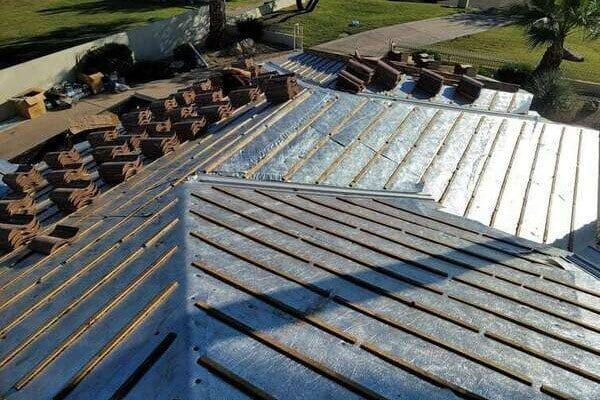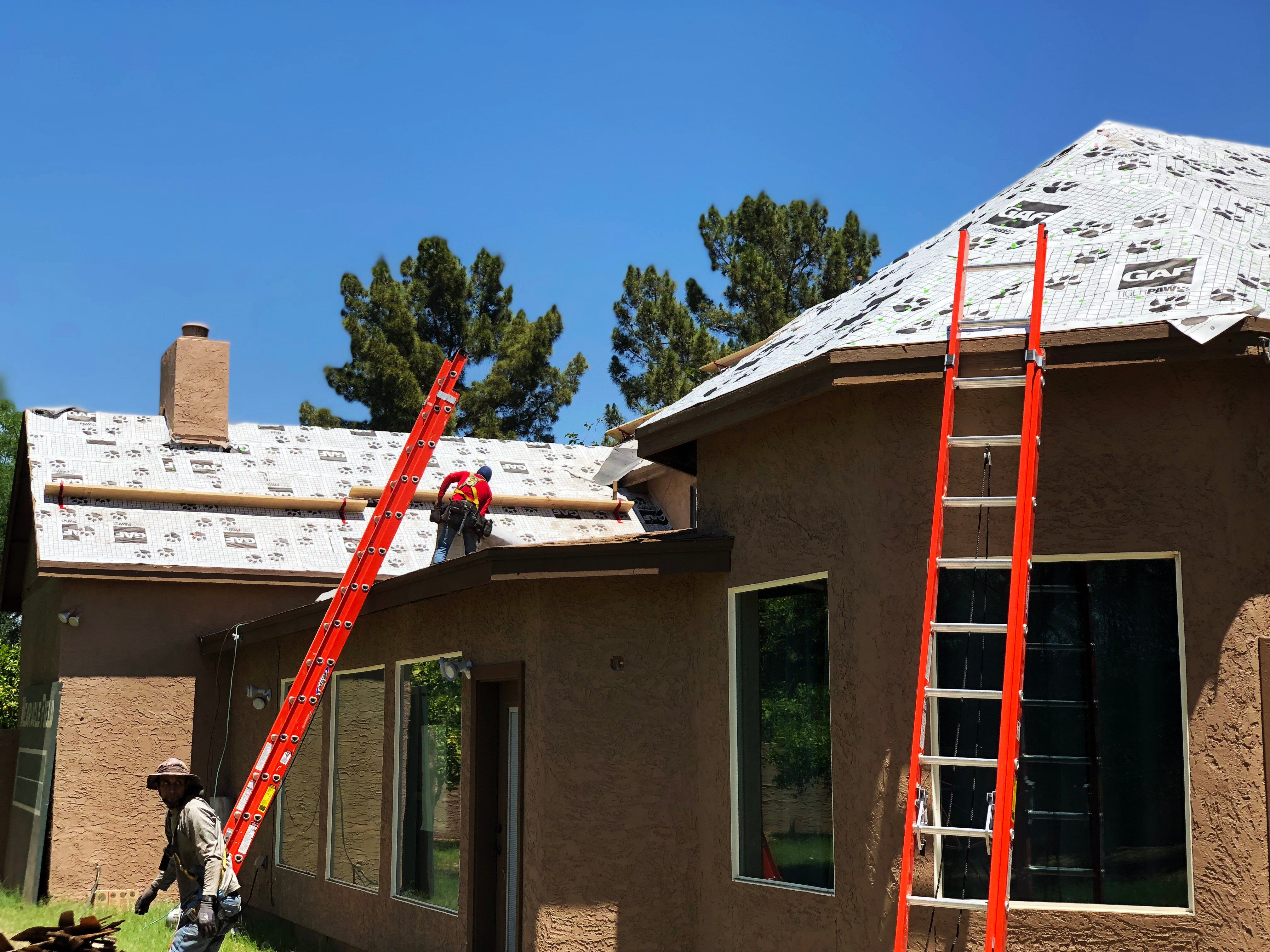Roof Underlayment 101: What It Is & Why It’s Important
Home / Azul Blog / Roof Underlayment 101: What It Is & Why It’s Important When most homeowners think about their roof, they picture the tiles, shingles, or foam that cover the top...
8 min read
Paul Hammons, Production Manager : February 05, 2025

Home / Azul Blog / What is Low-E Insulation & is it Good for My Roof?
When it comes to your roof as a system, you might think things are pretty black and white. You have your underlayment and roofing shingles or tiles on top of it. That's pretty much all that comes with it, right?
While that can be the case with many roofs, there are some additions and upgrades that you can include to help improve the health and longevity of your roof – or even help lower the amount of heat that transfers into your home.
One upgrade we recommend to nearly every homeowner we speak to is including Low-E insulation with their roof project. There are numerous benefits that come with this upgrade, but many homeowners haven't even heard of it. To help educate our customers on all things roofing, we'll be diving into what Low-E insulation is and how it can help your roof and your home in this blog.
Key takeaways:
Low-E insulation, like ThermaSheet, is an energy-efficient underlayment designed to reflect radiant heat and reduce heat transfer into your home. It acts as a thermal break under your roof that reflects nearly 100% of radiant heat to keep your home cooler in summer and warmer during winter. Low-E insulation is compatible with various roof types and can be installed under shingles, clay tiles, metal, and other roofing materials.
ThermaSheet is made from 99% pure-polished aluminum laminated to a closed-cell foam core, creating a durable, lightweight, and highly-effective insulation lower. The ‘Low-E’ refers to its low emissivity rating, which measures how much heat it emits.
One of the key features of ThermaSheet is its ability to self-seal around fasteners to ensure a secure, weather-tight fit – which is especially useful for metal roofs. It comes in various thicknesses, starting from ⅛”, and is a safe product with a Class A, Class 1 fire rating. For additional peace of mind, ThermaSheet comes with a 30-year warranty – though with professional installation it can last much longer than that.
To start answering this question, we first have to establish that all building products have an "E" rating," with most products scoring over .80. This rating stands for emissivity, which is the ability of a surface to give off heat to a cooler surface. Therefore, the lower the "E" rating, the less radiant heat a surface will give off.
There are three ways heat is transferred: conduction, convection, and radiation:
Low-E insulation protects your roof and home from all three types of heat transfer. It reflects radiant heat while also forming a thermal barrier to prevent heat transfer. It also naturally reduces conduction.
While Low-E insulation might sound like a radiant barrier, the two are different products. A radiant barrier is a foil or mylar that reflects radiant heat. Low-E thermal insulation doesn’t just reflect radiant heat but also provides a thermal break from conductive energy transfer.
This is the key differentiating factor, because the thermal break reduces how much energy is transferred between two surfaces.
The benefits of Low-E insulation include cooler attic temperatures, cost savings, and a smaller carbon footprint.
With Low-E thermal insulation, less heat is transferred into your attic from the roof above. Heat that would have otherwise ended up in your attic is instead reflected back out, leaving you with cooler attic temperatures. Although it’ll still be pretty warm in your attic during summer with Low-E, it can help make any necessary work up there more manageable.
By reducing the amount of heat that’s transferred, Low-E reflective insulation can also benefit your other roofing materials by keeping their temperatures low. This is beneficial for a number of reasons – the main one being a longer life for your roof.
As you probably know, our hot Arizona sun is harsh and can degrade roofing materials quicker than expected. By keeping a portion of that heat out and away from your other roofing materials, Low-E thermal insulation helps to expand the usable lifetime of your roofing system as a whole.
Additionally, Low-E insulation acts as a vapor and moisture barrier, which can provide protection for metal panels and fasters as well.
Read More: 4 Easy Tips to Maintain Your Roof's Health
The biggest benefit for homeowners installing Low-E thermal insulation is lower energy bills and more money in their pocket. As we’ve pointed out in the first two benefits, Low-E insulation means less heat energy transfer. This means there’s less heat entering your home, which means your HVAC system doesn’t have to work as hard to keep your house cool. Naturally, that translates to less electricity usage and lower energy bills.
Low-E insulation doesn’t just reduce heat transfer, it also serves as a vapor and moisture barrier. By preventing unwanted moisture buildup in places like attics, crawlspaces, and ceilings, it helps protect your home from mold, mildew, and structural damage.
One of the standout features of Low-E insulation is that it self-seals around fasteners. Traditional underlayments require thousands of nails penetrating a typical roofing system, which can leave small gaps for water to seep through. This can lead to leaks and roof rot over time. ThermaSheet is made from a closed-cell polyethylene foam core, which acts as a gasket around each nail to prevent moisture from sneaking in. This provides an additional layer of protection that keeps your roof dry and durable for decades.
One of the indirect benefits of Low-E insulation is that it can help reduce your carbon footprint. By relying less on your HVAC system, your home will be more energy-efficient, reducing your reliance on grid power and its related carbon emissions. Additionally, Low-E insulation can be cut to size to reduce waste.
Low-E insulation is relatively easy to install. Because it can be used as a standalone underlayment, it doesn’t require additional materials like felt. It’s lightweight –- weighing about 18lbs per 500 square feet – making for a quick installation, which means you can enjoy your new roof upgrade faster.
Low-E insulation can be used with various types of roofing materials, including metal, shingles, clay tiles, and more, making it a versatile insulation option.
Finally, Low-E ThermaSheet insulation is made from non-toxic materials for additional peace of mind.
Roof insulation is one of the most effective ways to improve your home’s energy-efficiency, reduce electricity costs, and create a more comfortable living environment year round.
Heating and cooling account for a significant portion of household energy use. The average air conditioner consumes around 10kWh on a hot summer’s day, which can add up to be a significant portion of your electric bill. Meanwhile, the average heater uses about 20kWh per day in the winter.
Without proper insulation, much of this energy is wasted as heat escapes in winter or enters in summer. By lowering strain on your HVAC systems and maintaining a more comfortable living environment, roof insulation can help reduce your electricity bills and save you money.
See More: Four Ways Your Roof Can Cut Your Electric Bill
In summer, your roof absorbs heat from the intense Arizona sun, which can quickly warm up your home. Without insulation, this heat radiates inside and makes it harder to keep your living spaces cool.
By adding a quality insulation layer, you can create a barrier that reflects heat away before it can get into your home. This helps keep indoor temperatures cool without overworking your air conditioner.
Insulation doesn’t just keep heat out during the summer – it also traps warmth inside during winter. The heat retention value (R-value) of insulation represents how well it resists heat transfer, with higher values meaning more-effective insulation.
Roof insulation can also help reduce noise pollution by reducing the transfer of noise from outside to inside. Whether it’s outside traffic, heavy rain, overhead planes, or high winds, insulation can dampen sound by reducing air movement and absorbing vibrations. It can also minimize noise transfer within your home, making your living environment more peaceful.
Roof insulation improves your home’s energy efficiency, which can help reduce your carbon footprint. Many power plants in the U.S. still rely on burning fossil fuels, which releases harmful emissions into the atmosphere. By insulating your roof, you’ll be reducing your household’s energy use and taking a small step towards a more sustainable future.
While Low-E insulation is our number one recommendation when it comes to roof insulation, there are various types out there that suit different applications and needs.
The most common types of roof insulation include:
Keep Reading: What Type of Roof Underlayment Do I Need?
Low-E insulation is an energy-efficient roof insulation option that can help keep your living spaces comfortable while reducing energy costs. Unlike traditional insulation types, which mainly slow down heat transfer, Low-E insulation actively reflects radiant heat. In Arizona, this means less of that harsh summer sun penetrating through the roof and into your home.
If you’d like to explore Low-E insulation, or see what your options are with other roof insulation types, contact our team for a free roof evaluation.
Low-E insulation, such as ThermaSheet, is an energy-efficient underlayment placed below roofing materials. It reflects up to 100% of radiant heat and acts as a thermal break—reducing heat transfer into your home in hot seasons and preserving warmth during cold weather
ThermaSheet is constructed from nearly 100% polished aluminum bonded to a closed-cell foam core. It’s lightweight, fire-rated Class A/Class 1, available in various thicknesses, and comes with a 30-year warranty when professionally installed
Unlike a radiant barrier—which only reflects radiant heat—Low-E insulation not only reflects heat but also provides a thermal break to reduce conduction and convection, making it significantly more effective at reducing total heat transfer
Benefits include:
Yes—Low-E is lightweight and simple to install without needing additional layers like felt. It works under shingles, clay tiles, metal, and more, and is made from non-toxic materials.
Yes—by reflecting heat and reducing thermal stress on roof materials, Low-E helps prevent accelerated degradation from Arizona’s harsh sun, extending their usable life
Yes—other common roof insulation types include spray foam, structural insulated panels (SIPs), rigid insulation boards, fiberglass batts, and loose-fill/blown-in insulation. Each has its own advantages depending on your needs and roof type

Home / Azul Blog / Roof Underlayment 101: What It Is & Why It’s Important When most homeowners think about their roof, they picture the tiles, shingles, or foam that cover the top...